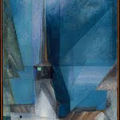Basic Design Terminology
Elements of Visual Language
Lines are points in motion. They are generated when we write, sketch or move our bodies through space. The primary types of line are contour, gesture, hatch, implied and object or symbolic lines. Contour lines delineate shapes (such as a silhouette), gesture lines capture motion, hatch lines group together to form an overall pattern (shading), object lines denote letters, numbers and other one-dimensional forms and implied lines are perceptually present but physically absent like a dotted line or a pointed finger.
Shapes or Forms are visually perceived areas created by an enclosing line.
Visual Space is the perception of three-dimensions on a two-dimensional picture plane. It is created through the relationship between forms The figure/ ground relationship; overlapping shapes; atmospheric and linear perspective; value; scale and color all contribute to the perception of depth
Texture is related to the sensation of touch. Actual texture refers to the plasticity of the material while visual texture is based on the differentiation of surface through pattern, rhythm or tactile references evoked by the imagery.
Value refers to the degree of lightness and darkness reflecting from a surface.
.
Color is the product of light. The psychological and optical effects of color, along with the symbolic and cultural aspects, make this element of the visual language especially complex and evocative.
Principles of Visual Language
Unity is a visual concept that refers to the integration of an image. When a composition is unified, the image is seen as a whole rather than a gathering of disparate parts.
Repetition and variation is a visual strategy used to achieve unity. One element of the composition is repeated – such as a shape, texture or color - while another element is in a state of variation. For example, images in a grid sequence use the repeat of the rectangle to support a diverse array of form.
Tension or contrast generates dynamism. It can be created through negative and positive relationships, implied space, visual movement or value relationships.
Emphasis or focal point is used to draw attention to one area in the work. It is often created by isolating a component of the composition through a shift in texture, color, value, scale, contrast or detail.
Pictorial balance is based on the equal distribution of visual weight. An asymmetrical balance is achieved using dissimilar forms that are equal in visual weight while symmetrical balance is based on using like shapes that mirror each other. A lack of balance weakens the overall unity of the pictorial structure.
Visual rhythm is generated by the repetition of form in variation. The repeating elements functions like musical beats that organize sound in sequenced motifs. Visual rhythm supports compositional unity, directional movement and sequence.
Scale refers to the size of a form in relationship to the depicted reference or the objects around it. The surrealist artists often played with scale relationships as means to communicate ideas.
Proportion refers to the relationship between the parts of an object to the whole or the relationship between an object and its context.
Reduction and simplicity is a process of refining and distilling the elements in a composition to communicate an idea with optimum precision and clarity.













